What is Asynchronous
Normally, most operations in an application with a graphical user interface (GUI), run on the UI Thread. That is the thread that starts the UI and listens to the events like clicking buttons and moving the mouse. When you click on a button, the code behind that button runs on the UI thread.
Asynchronous (Async for short) operations run on Non-UI threads and do not freeze the UI.
If the task is time-consuming, the UI thread (now executing the task after button click) can not respond to any other events. Therefore UI is “Frozen” (not the Disney® movie) and unresponsive. Normally this is ok since you would not want the user to change the document while the task is running. It is a good idea to use Non-UI threads for time-consuming tasks and run them Asynchronously.
Async in Script Editor
In Rhino Script Editor, if a script is performing a time-consuming task, clicking on the Run button would cause Rhino UI to freeze for the duration of the script. As we mentioned above this is ok. However, if your task does not deal with the Rhino document (could be changed by the Rhino user while your script is running), it could be made async. This would make Rhino UI responsive while your script is running. It is also a good habit to show progress while the task is running in the background:
- In C#, add
// async:trueto the top of your script. - In Python, add
# async:trueto the top of your script.
When script is marked as async: true the Script Editor runs the full script on a Non-UI thread. This is a feature of Rhino Script Editor and not the scripting language. You can remove this line or set it to false to make the script synchronous again.
Asynchronous C#
The example C# script below completely freezes Rhino UI for about 2 seconds. That the amount of time we are specifying in Thread.Sleep to simulate work. This could be a long running computation or waiting to receive some data from web:
// #! csharp
using System;
using System.Threading;
using Rhino;
RhinoApp.WriteLine("Start Task");
Thread.Sleep(2000); // simulate work
RhinoApp.WriteLine("End Task");
By adding the line // async:true, we can force this complete script to run on a Non-UI thread, keeping Rhino UI active so we can continue working while the script is running:
// #! csharp
// async:true
using System;
using System.Threading;
using Rhino;
RhinoApp.WriteLine("Start Task");
Thread.Sleep(2000); // simulate work
RhinoApp.WriteLine("End Task");
Notice that this is the only change we made to the script. Also note that the Run button in Script Editor dashboard now shows a red arrow to represent the async execution of this script:
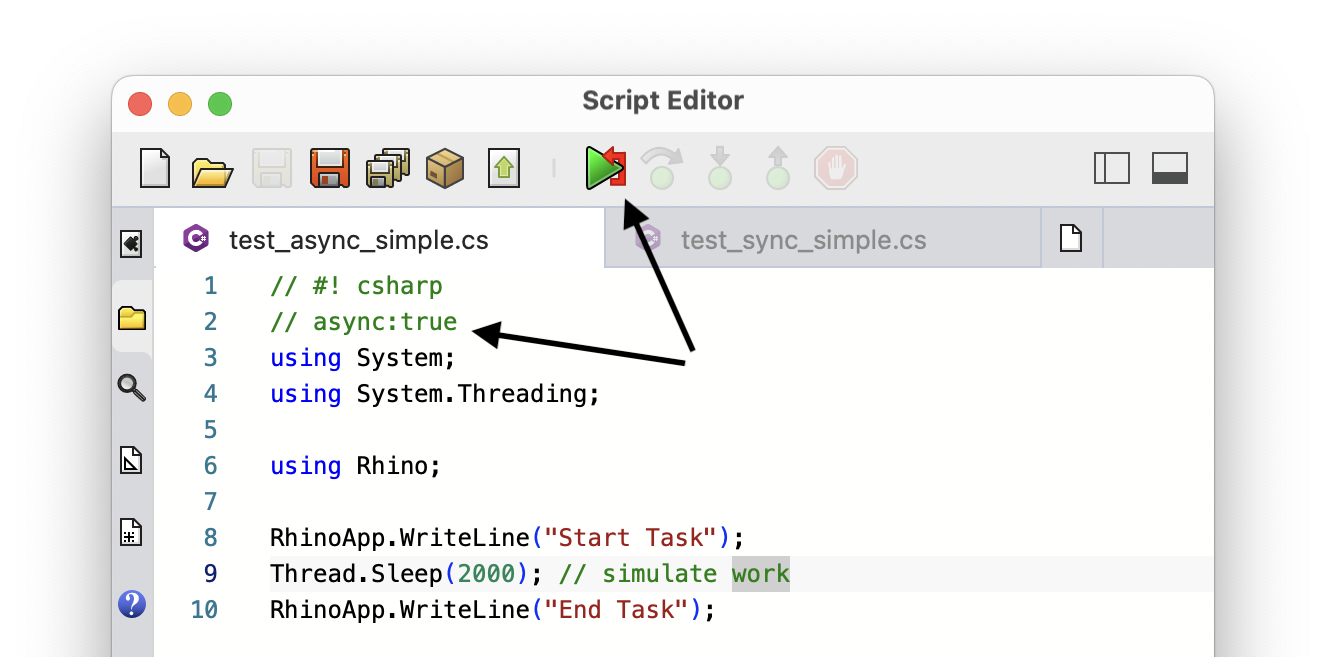
Asynchronous Python
The example Python script below completely freezes Rhino UI for about 2 seconds. That the amount of time we are specifying in time.sleep to simulate work. This could be a long running computation or waiting to receive some data from web:
#! python3
import threading
import time
class Job(threading.Thread):
def __init__(self, id, name, wait):
super().__init__()
self.id = id
self.name = name
self.wait = wait
def run(self):
print("Starting " + self.name)
time.sleep(self.wait) # wait to simulate work
print(f"Done {self.name}: {time.ctime(time.time())}")
job1 = Job(1, "Job-1", 2)
job1.start()
job1.join()
print("Complete")
By adding the line # async:true, we can force this complete script to run on a Non-UI thread, keeping Rhino UI active so we can continue working while the script is running (this is a feature of Rhino Script Editor and not Python language):
#! python3
# async: true
import threading
import time
class Job(threading.Thread):
def __init__(self, id, name, wait):
super().__init__()
self.id = id
self.name = name
self.wait = wait
def run(self):
print("Starting " + self.name)
time.sleep(self.wait) # wait to simulate work
print(f"Done {self.name}: {time.ctime(time.time())}")
job1 = Job(1, "Job-1", 2)
job1.start()
job1.join()
print("Complete")
Notice that this is the only change we made to the script. Also note that the Run button in Script Editor dashboard now shows a red arrow to represent the async execution of this script:
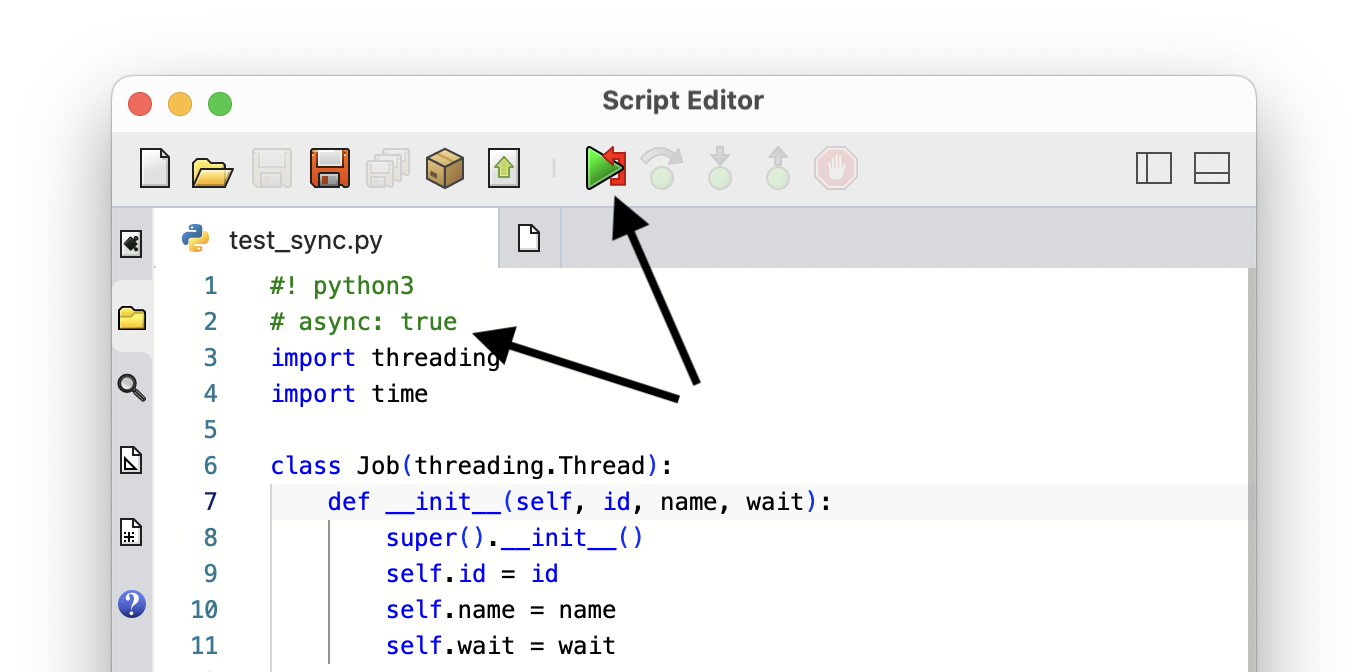
Show Progress
It is a good practice to show feedback on the progress of background tasks. Rhino UI has a progress indicator on the status bar. This is an example of how you can use this progress bar in your scripts. Thread.Sleep is used below to simulate work:
// #! csharp
using System;
using System.Threading;
using Rhino;
using Rhino.UI;
using Eto.Forms;
// setup the progress indicator with expected range, and a message
StatusBar.ShowProgressMeter(0, 5, "Progress", embedLabel: true, showPercentComplete: false);
RhinoApp.WriteLine("Start Task");
for (int i = 0; i < 5; i++)
{
Thread.Sleep(1000); // simulate work
// update progress
StatusBar.UpdateProgressMeter("Progress", i, true);
// since we are on the main thread here,
// call this method to force Rhino UI to update
Application.Instance.RunIteration();
}
// do not forget to hide the progress when done
StatusBar.HideProgressMeter();
RhinoApp.WriteLine("End Task");
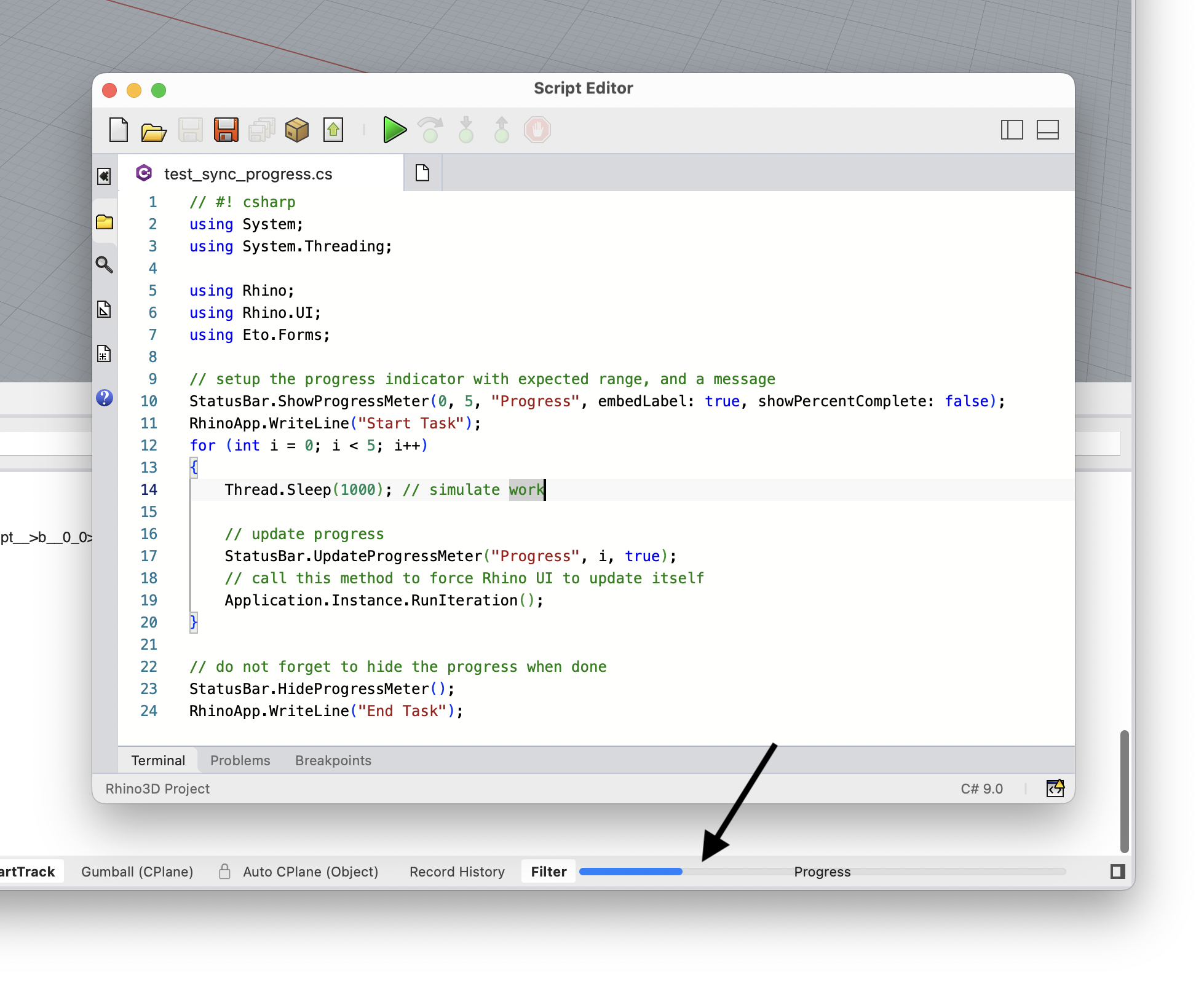
Python Progress
In Python you can use rhinoscriptsyntax module to access the progress indicator easier:
import rhinoscriptsyntax as rs
from Rhino import RhinoApp
MAX = 1000
rs.StatusBarProgressMeterShow("Progress", 0, MAX)
for i in range(0, MAX):
rs.StatusBarProgressMeterUpdate(i)
rs.StatusBarProgressMeterHide()
Async in Grasshopper
async: true pattern is NOT SUPPORTED in Grasshopper, since it needs to wait for the script to fully execute and set the output data before executing the rest of component graph. We can however have background threads running computations, and continuously trigger a Grasshopper solve to update the results.This is an example of a python script component that runs computation on background thread. We use the Trigger component is Grasshopper to recompute this component on intervals and therefore update the geometry previews in Rhino:
RunScriptsets up the worked thread on the first run. It does not do anything on later runs except for outputing"Training in Progress"and the current state of compute meshmain_solveis the solver function that is being executed by the worker thread. It updates the class variableMyComponent.CURRENT_MESHwhile runningDrawViewportMeshesis called by Grasshopper after each trigger and displays the current state of computed mesh inMyComponent.CURRENT_MESH
import System
import System.Drawing as SD
import Rhino
import Rhino.Geometry as G
import Grasshopper
import Grasshopper.Kernel as GHK
import threading
import time
def main_solve():
for r in range(10, 20):
# wait represents compute work
Rhino.RhinoApp.WriteLine("computing mesh")
time.sleep(1)
sphere = G.Sphere(G.Point3d.Origin, r)
MyComponent.CURRENT_MESH = G.Mesh.CreateFromSphere(sphere, 10, 10)
Rhino.RhinoApp.WriteLine("computed mesh")
Rhino.RhinoApp.WriteLine("computed completed")
class MyComponent(Grasshopper.Kernel.GH_ScriptInstance):
SOVLE_STARTED = False
CURRENT_MESH = None
def RunScript(self):
if MyComponent.SOVLE_STARTED:
return ("Training in Progress", MyComponent.CURRENT_MESH)
MyComponent.SOVLE_STARTED = True
threading.Thread(target=main_solve).start()
return ("Training in Progress", None)
@property
def ClippingBox(self):
return G.BoundingBox(-30, -30, -30, 30, 30, 30)
def DrawViewportMeshes(self, args: GHK.IGH_PreviewArgs):
if d := getattr(args, "Display", None):
if MyComponent.CURRENT_MESH:
d.DrawMeshWires(MyComponent.CURRENT_MESH, SD.Color.Blue, 2)
Notice that Rhino UI stays active during this background computation:
Advanced Async
Sometime it is necessary to run operations on the UI thread before or after completing a time-consuming operation. Remember that the async:true mechanism mentioned above is for convenience and runs the complete script on a Non-UI thread. Based on the script language, you can use the threading or async features on the language to perform more complicated sync/async operations.
This is an example C# script that runs on UI thread on parts A and C of the script (blocking), and has a time-consuming operation on part B. Rhino UI is frozen during the blocking portions, but is fully available otherwise. Notice that:
-
Script specifies
// async: true. This means that the complete script is running on Non-UI thread. -
To make sure parts A and C are running on UI thread and can make changes to Rhino, we use
Application.Instance.Invoke. This method is provided by Eto which is the UI framework Rhino >=8 uses, and ensures the given action runs on the UI thread. -
On part B, script is calling
.GetAwaiter().GetResult()on theTask<int>object created byTask.Runcall. This is to ensure execution waits for the task to complete and we have the result before proceeding to part C. Also notice that callingApplication.Instance.RunIterationis not necessary here and causes a crash if called.
// #! csharp
// async: true
using System;
using System.Threading;
using System.Threading.Tasks;
using Rhino;
using Rhino.UI;
using Eto.Forms;
// Part A: runs on UI thread (blocking)
Application.Instance.Invoke(() => {
// CAN MAKE CHANGES TO RHINO or DOCUMENT HERE
StatusBar.ShowProgressMeter(0, 5, "Progress", true, false);
});
// Part B: runs on Non-UI thread
int result = Task.Run(() => {
for (int i = 0; i < 5; i++)
{
Thread.Sleep(1 * 1000);
StatusBar.UpdateProgressMeter("Progress", i, true);
// DO NOT CALL THIS SINCE WE ARE NOT ON UI THREAD
// Application.Instance.RunIteration();
}
return 42;
}).GetAwaiter().GetResult();
// Part C: runs on UI thread (blocking)
Application.Instance.Invoke(() => {
// CAN MAKE CHANGES TO RHINO or DOCUMENT HERE
RhinoApp.WriteLine($"Result: {result}");
StatusBar.HideProgressMeter();
});
You can also debug this script by placing breakpoints inside the scope of each part. Notice how the first and last breakpoints are paused on Thread 1 (main and UI thread in Rhino), but the breakpoint on line 19 is paused on Thread 15 which happens to be the thread used to run the task by dotnet runtime:
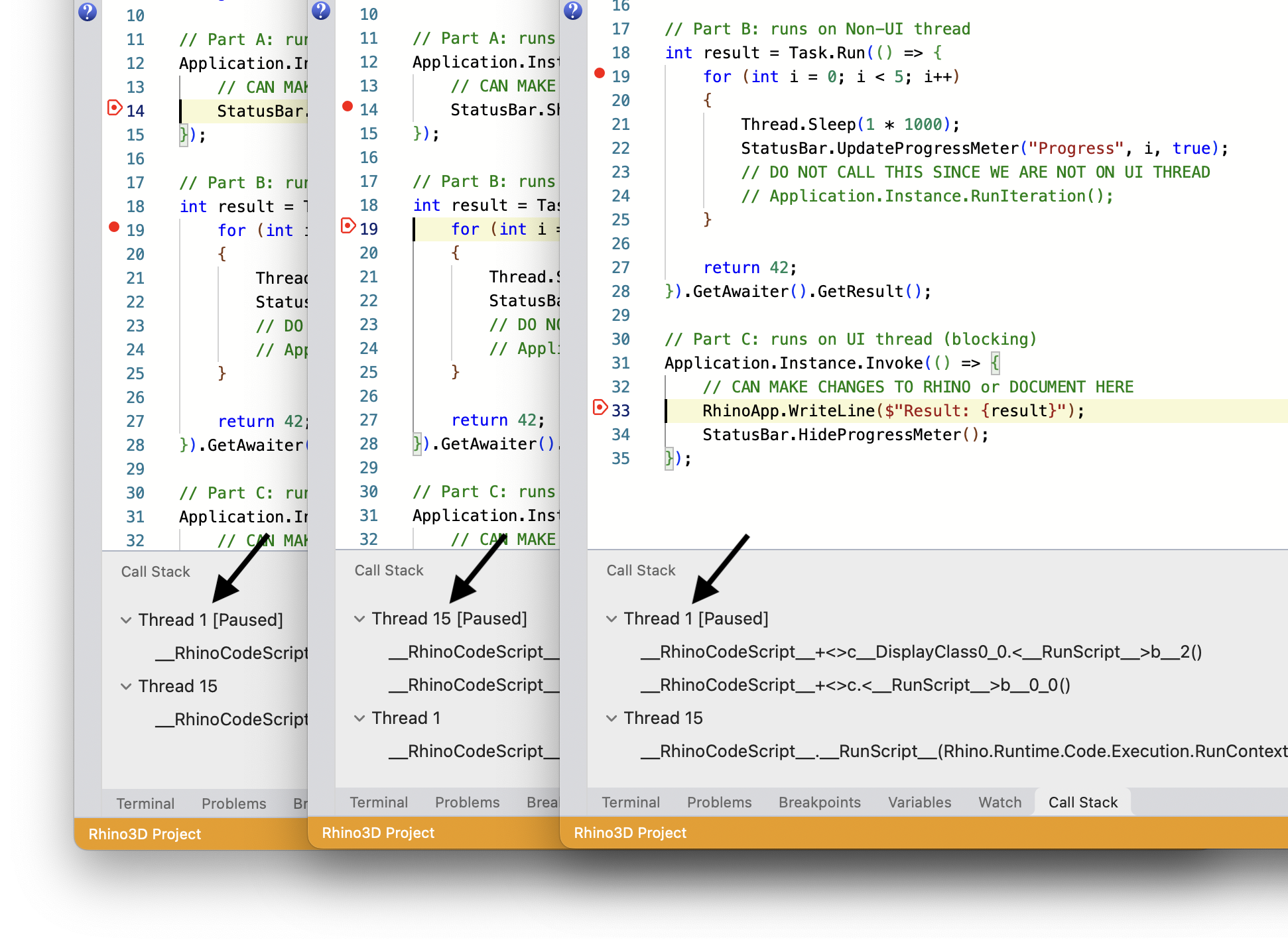
Here is a similar example in Python. Note that we are using rhinoscriptsyntax to handle the progress indicator. part_a and part_c functions are executed on the main UI thread, and the middle part is executed on the new thread created in the script:
#! python3
# async: true
import threading
import time
import rhinoscriptsyntax as rs
from Rhino import RhinoApp
from Eto.Forms import Application
class Job(threading.Thread):
def __init__(self, id, name):
super().__init__()
self.id = id
self.name = name
self.result = 0
def run(self):
thread_id = threading.current_thread().ident
print(f"Starting {self.name} on Thread: {thread_id}")
for i in range(5):
time.sleep(1) # wait to simulate work
rs.StatusBarProgressMeterUpdate(i)
self.result = 42
print(f"Done {self.name}: {time.ctime(time.time())}")
def part_a():
# CAN MAKE CHANGES TO RHINO or DOCUMENT HERE
thread_id = threading.current_thread().ident
print(f"Thread: {thread_id}")
rs.StatusBarProgressMeterShow("Progress", 0, 5)
def part_c(result):
# CAN MAKE CHANGES TO RHINO or DOCUMENT HERE
thread_id = threading.current_thread().ident
print(f"Thread: {thread_id}")
print(f"Result: {result}")
rs.StatusBarProgressMeterHide()
RhinoApp.ClearCommandHistoryWindow()
Application.Instance.Invoke(part_a)
job1 = Job(1, "Job-1")
job1.start()
job1.join()
result = job1.result
Application.Instance.Invoke(lambda: part_c(result))
print("Complete")
Notice that the thread id matches for part_a and part_c, but the middle section is executed on a thread with a different id. Also note that thread identifiers are different from dotnet thread ids when using C#:
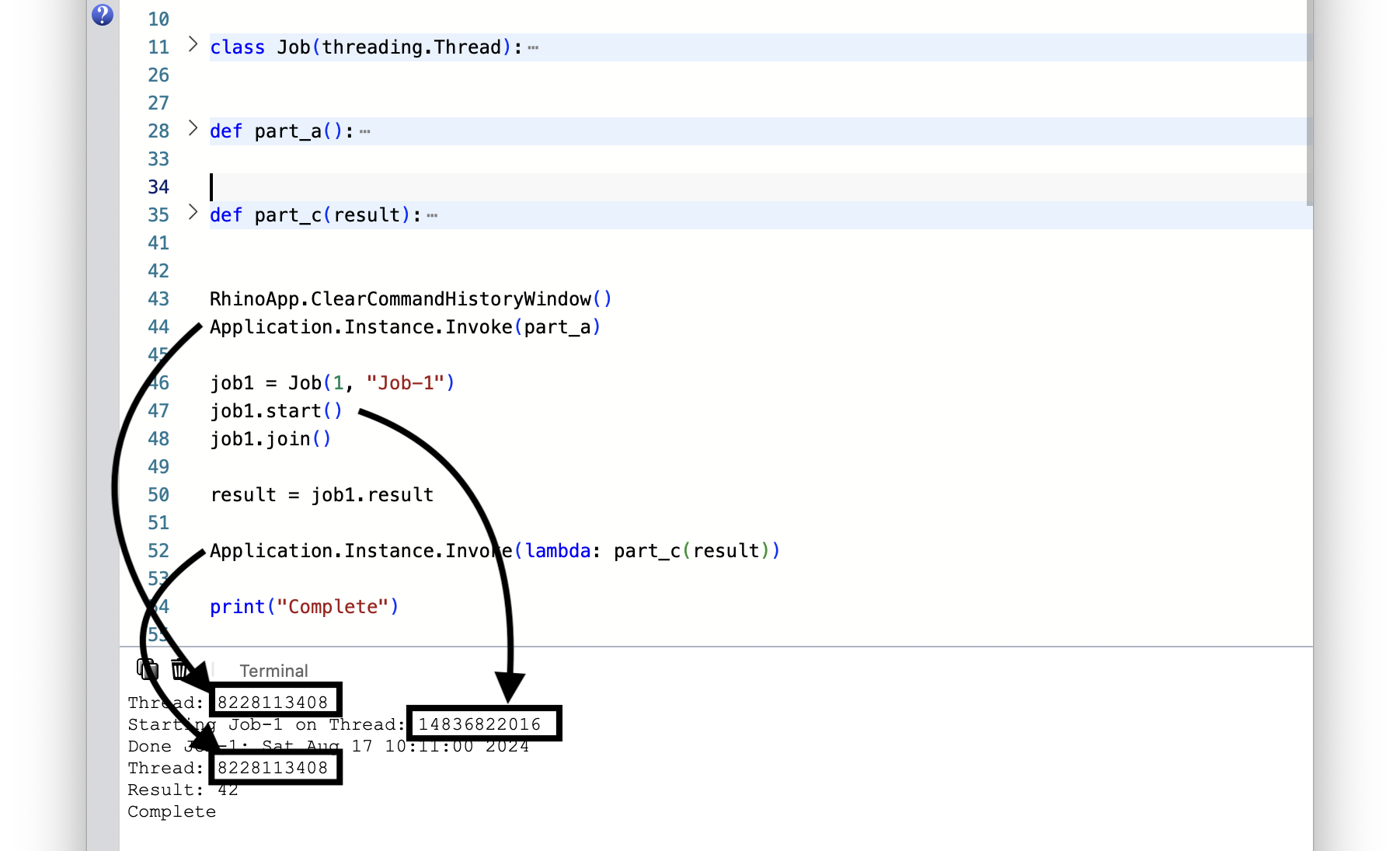
C# Async/Await
In C# (Rhino >= 8.12) you can use async/await for asynchronous programming. Here is an example of creating an async function in the script editor:
// #! csharp
// async: true
using System;
using System.Threading;
using System.Threading.Tasks;
async Task<int> Compute()
{
await Task.Delay(TimeSpan.FromMilliseconds(2000));
return 42;
}
int result = await Compute();
Console.WriteLine($"Result: {result}");
Notice that if we remove the // async: true line or set that to false the editor shows an error on the await call in global scope:
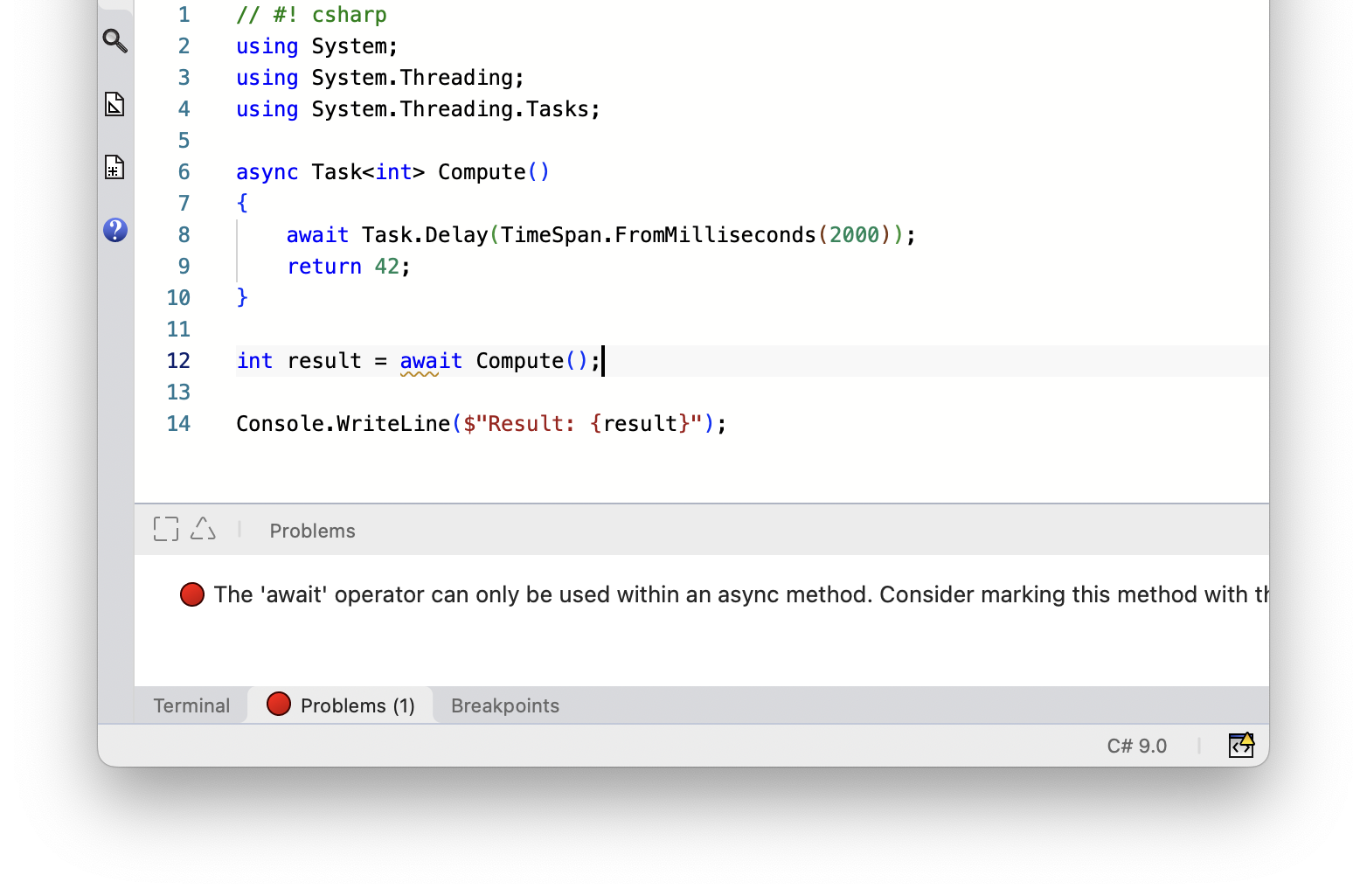
When running C# scripts, the editor recomposes the script into something that looks like the example below. This is done so multiple instances of the same script can be created, holding onto their own internal states, and executed using different contexts. Notice that the main __RunScript__ method is NOT marked as async:
sealed class __RhinoCodeScript__ {
public void __RunScript__(Rhino.Runtime.Code.Execution.RunContext __context__)
{
// YOUR SCRIPT IS EMBEDDED HERE
}}
When using await in global scope, we need to mark the script as // async: true to ensure __RunScript__ is marked as async and returns a Task instance so the editor can await the execution:
sealed class __RhinoCodeScript__ {
public async Task __RunScript__(Rhino.Runtime.Code.Execution.RunContext __context__)
{
async Task<int> Compute()
{
await Task.Delay(TimeSpan.FromMilliseconds(2000));
return 42;
}
int result = await Compute();
Console.WriteLine($"Result: {result}");
}}

